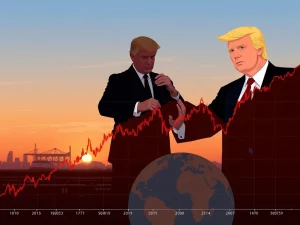Defying Chaos: Crypto Markets Show Surprising Stability Amid Trump Tariffs

In a world gripped by economic uncertainty, one corner of the financial landscape is exhibiting surprising resilience: crypto markets. While traditional markets reel from the shockwaves of former US President Donald Trump’s unpredictable tariff policies, cryptocurrencies are maintaining a ‘relatively orderly’ stance, according to analysts at New York Digital Investment Group (NYDIG). Is this a fleeting anomaly, or does it signal a fundamental shift in how investors perceive digital assets in times of global economic turbulence?
Why are Crypto Markets Showing Unexpected Stability Amid Trump Tariffs?
Greg Cipolaro, global head of research at NYDIG, points to intriguing indicators suggesting a unique dynamic within the crypto markets. Despite the wider market panic triggered by Trump’s ‘on-again, off-again’ tariff regime, crypto futures rates have remained consistently positive. This is a stark contrast to historical patterns where risk-off sentiments typically spill over and stress crypto assets.
Cipolaro highlights that even the liquidation spikes following Trump’s initial tariff announcements on April 2nd were relatively contained. While liquidations did jump on April 6th and 7th, reaching $480 million, this figure pales in comparison to other significant liquidation events in the crypto space. Furthermore, Tether (USDT), a stablecoin pegged to the US dollar and crucial for crypto trading, remained below $1 but avoided a sharp decline, indicating a degree of underlying stability.
To recap, here’s a breakdown of why crypto markets are weathering the storm:
- Persistent Positive Futures Rates: Unlike traditional markets reacting negatively, crypto futures suggest continued confidence.
- Contained Liquidations: Spikes were less dramatic than previous market stresses, showing resilience.
- Stable Stablecoin Behavior: Tether’s performance indicates a lack of extreme panic selling within crypto.
It’s worth remembering the timeline of events. Trump’s tariff announcement on April 2nd initially sent shockwaves through both traditional and crypto markets. Stocks, bonds, and foreign exchange volatility all surged. However, the crypto sector seems to have found a footing relatively quickly, suggesting a decoupling from traditional market anxieties.
Bitcoin Volatility: Has Bitcoin Become a Haven Asset?
While Bitcoin volatility is often a topic of concern, in this instance, it might be working in its favor. Cipolaro notes that Bitcoin, while not immune to the market turbulence, has “fared far better than many other asset classes.” Crucially, unlike traditional markets, Bitcoin’s volatility has not spiked to historic levels; it has remained “relatively stable” despite the external instability.
Could this be a sign of investors seeking refuge in assets perceived as detached from sovereign economic policies? Cipolaro suggests this possibility, stating, “Perhaps investors are increasingly searching for stores of value not tied to sovereign countries and thus not affected by the trade turmoil.” This idea of Bitcoin as a form of ‘digital gold’ or an uncorrelated asset gains traction during times of global economic uncertainty.
Here’s a comparative look at market reactions:
| Asset Class | Reaction to Trump Tariffs | Volatility |
|---|---|---|
| Traditional Markets (Stocks, Bonds, Forex) | Negative, Market Tanked | Increased |
| Crypto Markets (Bitcoin) | Relatively Stable | Stable, Not Spiked |
Market Stability and Risk Parity Funds: A New Era for Bitcoin Adoption?
The narrowing gap between Bitcoin volatility and that of traditional assets is making Bitcoin “increasingly more appealing” to risk parity funds, according to Cipolaro. These funds allocate assets based on risk, and Bitcoin’s newfound relative stability could trigger increased allocation. Investors, seeking to reduce overall risk exposure, might be re-evaluating their portfolios and considering Bitcoin as a diversifier.
This potential influx of institutional capital from risk parity funds could create a “virtuous cycle.” As these funds allocate to Bitcoin, it could further dampen its volatility, making it even more attractive to a wider range of investors. This increased adoption, in turn, could reinforce market stability and solidify Bitcoin’s position in the broader financial ecosystem.
A Word of Caution: Is a Bearish ‘Death Cross’ on the Horizon?
While the NYDIG analysis paints a picture of relative crypto market stability, it’s crucial to consider dissenting voices. Ruslan Lienkha, chief of markets at YouHodler, offers a more cautious perspective. He points to “technical indicators painting a concerning picture.” Specifically, Lienkha highlights the potential formation of a “death cross” on both Bitcoin and the S&P 500 charts.
A “death cross” occurs when the 50-day moving average dips below the 200-day moving average. This pattern is often interpreted as a bearish signal, suggesting potential downward momentum in the medium term. Lienkha cautions that markets may struggle to maintain upward trajectory without a significant positive catalyst or macroeconomic boost.
Therefore, while crypto markets have shown resilience in the face of Trump tariffs, it’s essential to remain vigilant and consider both bullish and bearish perspectives. The interplay between macroeconomic factors, technical indicators, and investor sentiment will ultimately determine the future trajectory of the crypto landscape.
Conclusion: Navigating the Crypto Landscape Amidst Global Uncertainty
The current market scenario presents a fascinating paradox. Amidst the chaos of global trade tensions and traditional market volatility, crypto markets, particularly Bitcoin, are exhibiting surprising stability. While caution remains warranted, the analysis from NYDIG suggests a potential shift in perception, with Bitcoin emerging as a potential store of value and a diversifier in turbulent times.
Whether this marks a fundamental change in Bitcoin’s role or a temporary anomaly remains to be seen. However, the resilience displayed by crypto markets in the face of Trump tariffs offers a compelling narrative – a testament to the evolving nature of digital assets and their potential to navigate the complexities of the modern global economy. Keep a close eye on these developments, as they could signal significant shifts in the financial world.








